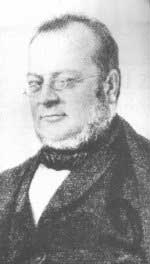Count Camillo Benso di Cavour
|
|
Count Camillo Benso di Cavour (Turin, August 10, 1810 - Santena, near Turin, June 6, 1861) was a statesman who was a leading figure in the movement toward Italian unification and the first Prime Minister of the new Kingdom of Italy.
Early Political Career
With the election of the liberal Pope Pius IX to the papacy in 1846, Cavour felt that the chance for him to advocate reform had come. In 1847 he founded Il Risorgimento ("The Resurgence," later to become a general term for the unification of Italy), a newspaper espousing liberalism, constitutionalism, and unification. As editor, he soon became a powerful figure in Sardinian politics.
During 1848, a wave of violent revolutions swept Europe. The uprising in the Kingdom of the Two Sicilies terrified King Charles Albert of Piedmont-Sardinia. Pressured by the influence of Il Risorgimento and by the mood of dissent in his kingdom, Charles Albert granted Sardinia a constitutional law (Statuto Albertino) on February 8, 1848. Supported by this success, Cavour then turned to urging Charles Albert to declare war against Austria, which at that time ruled much of Italy either directly or through petty Hapsburg vassals. The perfect opportunity arose on March 19 when news arrived in Turin that Milan was in revolt against its Hapsburg ruler. On March 15, caving in to pressure from Cavour and his party, Charles Albert declared war on Austria.
Although Sardinia was defeated by Austria at the Battle of Novara and Italian revolutions were crushed in Lombardy, Venetia and Rome, liberalism and nationalism in Italy were still resurgent - in the July elections of 1848, Cavour won a seat in the Sardinian Chamber of Deputies, and after his defeat by the Austrians, Charles Albert abdicated in favor of his more liberal and powerful son, Victor Emmanuel II. Under Victor Emmanuel's monarchy, Cavour's political career flourished. He became Minister of Agriculture and Commerce in 1850 and Minister of Finance in 1851.
After the failure of the revolutions of 1848 to overrun monarchies in Europe, Cavour reassessed his liberal beliefs and decided to abandon his idealism for realpolitik. Cavour reasoned that even if Italy could not be united by revolution, strong and calculating leadership might stand a chance. In his first two government positions, Cavour worked hard to strengthen Sardinia, reorganizing its army, legal system, financial system, and bureaucracy. He secured liberty of the press and favored tolerance of religion (in opposition to the pope) and freedom of trade. He also encouraged the development of industry, including building railroads and factories, making Sardinia one of the most modernized European states of the time.
Path to Unification
Francesco_Hayez_041.jpg
On November 4, 1852, Cavour became Prime Minister of Piedmont-Sardinia. As Prime Minister, Cavour finally had an opportunity to extend his power into the realm of foreign affairs. In 1854, at the outbreak of the Crimean War, he saw his opportunity to enhance his nation's international standing. Sardinia entered the war (February 1855) as an ally of Great Britain and France in exchange for promises that the future of Italy would be seriously considered as an international issue. After the war, Cavour was able to sit on the Congress of Paris. At the time, this was of little benefit to Italy: the issues under discussion were to do with the aftermath of the Crimean War and did not concern Italy as such. It did provide the opportunity for Cavour to denounce Austria's occupation of Italy, arrange to meet Napoleon III, Emperor of France, an important ally in any Italian war against Austria, and establish Cavour as a voice for Italy.
Napoleon III, a quasi-liberal, sympathized with Cavour's plan for a Northern Italian Kingdom, and in July 1858 the two met at Plombières to shape Italy's future. At the meeting, Napoleon agreed that if Austria were to attack Sardinia, France would enter the war on Sardinia's side. Cavour immediately set to provoking Austria into war, and in April 1859 Austria attacked the small Italian state. However, after extremely costly victories at Magenta and Solferino, Napoleon III decided to withdraw from the war with the Truce of Villafranca. The treaty allowed the Austrians to keep Venetia and transferred the territories conquered by the Sardinians to their former rulers. Sardinia received only Lombardy. Although Cavour was furious at Napoleon, the situation soon reversed itself when the citizens of Tuscany, Modena, Parma, Bologna, and Romagna voted through plebiscites in March of 1860 to become part of Sardinia. Napoleon recognized these annexations in return for Savoy and Nice.
Soon after, the Italian patriot Giuseppe Garibaldi led his famous army of a thousand red-shirted adventurers into the Kingdom of the Two Sicilies (May 1860), and Victor Emmanuel led his troops into the province of Umbria. Both areas voted for union with Sardinia, and the Kingdom of Italy was proclaimed in March of 1861. Cavour's territorial aims were complete except for Venetia and Rome—two months later, the Prime Minister died. Venetia was added to the kingdom in 1866, and Rome in 1870.

